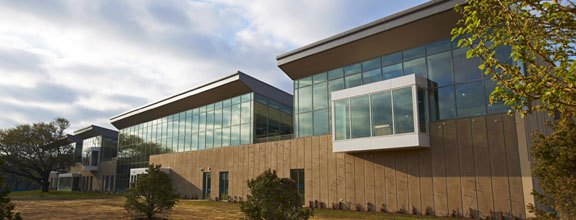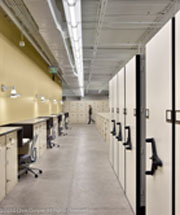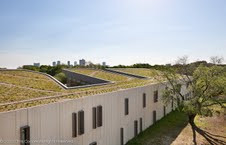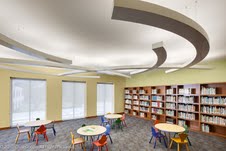BRIT includes a state-of-the-art herbarium with more than 1 million specimens. Photos courtesy of BRIT.
Aug. 18, 2011
Fort Worth is known for its world-class museums of art, western culture and science. Now the city’s Cultural District boasts a “green” gem.
The Botanical Research Institute of Texas (BRIT) held the grand opening of its new eco-friendly, LEED Platinum facility next to the Fort Worth Botanic Garden in May. Many people with a keen interest in the environment have not heard of this fantastic institution, yet.
 Shown here is the north-facing elevation of BRIT’s new home at 1700 University Drive in Fort Worth, Texas. Large windows let warming direct sunlight into the building in winter and shade the building interior during the summer to keep it cool. All the while, indirect light provides natural illumination to many work stations, decreasing reliance on energy consumption.
Shown here is the north-facing elevation of BRIT’s new home at 1700 University Drive in Fort Worth, Texas. Large windows let warming direct sunlight into the building in winter and shade the building interior during the summer to keep it cool. All the while, indirect light provides natural illumination to many work stations, decreasing reliance on energy consumption.
The international scientific research and learning center is a resource for scientists, teachers, students, farmers, gardeners and plant lovers. In addition to sharing knowledge about plants, BRIT aims to be a model for conservation and sustainable living.
The nonprofit has come along way since its beginnings in 1987.
BRIT was built around a Southern Methodist University collection compiled by renowned Texas botanist and SMU professor Lloyd H. Shinners. It contained 450,000 dried plant specimens and a botanical library with 75,000 volumes. In 1991, when BRIT was looking for a new home, the city of Fort Worth lured the organization over, wanting to add to its rich botanical resources, including the Fort Worth Botanic Garden and the Fort Worth Nature Center and Refuge.
In 1993, the institute began to grow after the board hired Dr. Sy Sohmer as director. He left a state department job with the Agency for International Development in Washington, DC to take the position.
“Everybody thought I was crazy coming down here,” said Sohmer.
While Sohmer had been promoting conservation programs in third-world countries as a senior government biodiversity advisor, he immediately saw the potential to make a world-class facility right here in the U.S.
 “My vision from the beginning was a building,” he said.
“My vision from the beginning was a building,” he said.
Almost 20 years later, that vision became a reality. Today, the new 70,000-square-foot building includes a state-of-the-art herbarium with more than 1 million specimens, a 125,000-volume research library, a children’s library, classrooms, meeting rooms and gift shop.
The building is the first in Tarrant County to earn the U.S Green Building Council’s highest LEED rating, Platinum. It features a solar photovoltaic system, which supplies 14 percent of the building’s energy and a geothermal heating and cooling system. Water is conserved with low-flow fixtures, while rainwater is collected for landscaping in two cisterns and a water pond.  Most notable is the building’s living roof, topped with plants transplanted from a nearby prairie. (photo on right) The green roof reduces the heat island effect, keeps the building insulated and provides habitat for butterflies and birds. This spring, it bloomed with bluebonnets and Indian Paintbrushes and became home to some ground nesting doves.
Most notable is the building’s living roof, topped with plants transplanted from a nearby prairie. (photo on right) The green roof reduces the heat island effect, keeps the building insulated and provides habitat for butterflies and birds. This spring, it bloomed with bluebonnets and Indian Paintbrushes and became home to some ground nesting doves.
“Every building in the city should have one,” said Sohmer.
The 5-acre campus also includes a restored prairie, which the staff is studying. Research is a big part of BRIT’s mission and its scientists are conducting research all over the world in areas where rich plant diversity still exists but is disappearing, including North Texas.
 The institute also provides education programs for teachers, which they can share with their classrooms, as well as programs for children and adults, in addition to publishing scientific journals and books. The heart of the nonprofit is the plant collection but it’s always been more than that, said Sohmer. He believes that BRIT’s role in the community is helping people see the importance of plants, their interrelationships and the need to conserve them.
The institute also provides education programs for teachers, which they can share with their classrooms, as well as programs for children and adults, in addition to publishing scientific journals and books. The heart of the nonprofit is the plant collection but it’s always been more than that, said Sohmer. He believes that BRIT’s role in the community is helping people see the importance of plants, their interrelationships and the need to conserve them.
“We’re part of the global battle to save biodiversity,” said Sohmer.
Stay up to date on everything green in North Texas, including the latest news and events! Sign up for the weekly Green Source DFW Newsletter! Follow us on Facebook and Twitter.









